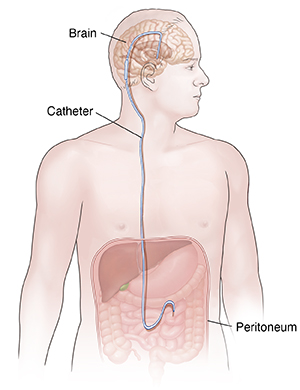Ventriculoperitoneal (VP) shunting is a type of brain surgery. It’s done to drain extra cerebrospinal fluid (CSF) from the brain. A tube (catheter) is put in the brain. This tube runs under the skin to the lining of the abdomen (peritoneum). It carries CSF away from the brain, where it is safely absorbed by the body. A small valve connected to the tube helps control the flow of CSF from the brain.
How to say it
vehn-TRIHK-yuh-loh-pehr-eh-tuh-NEEL
Why is VP shunting done?
VP shunting is done to treat hydrocephalus. This condition is sometimes called “water on the brain.” It means that too much CSF has built up in the brain. Having too much of this fluid can cause too much pressure on the brain, leading to brain damage. VP shunting may also be done to ease increased pressure if you have idiopathic intracranial hypertension (IIH).
CSF surrounds your brain and spinal cord and acts as a cushion. Your brain normally has a certain level of CSF in it. Several conditions may lead to excessive CSF buildup. This might be from congenital health conditions, a stroke, a tumor, or a blow to the head. Hydrocephalus may also occur for no known reason in older adults. In IIH, CSF pressure builds up for an unknown reason. It causes headaches and loss of sight.
How is VP shunting done?
VP shunting is done in a hospital.
-
You lie face-up on the operating table. A health care provider may place a headrest under your head to better align your body and head for the surgery.
-
You are given medicine to make you fall asleep. You won’t feel any pain. You may also be given antibiotics to prevent an infection.
-
A small area of hair on your head may be trimmed. This is where the surgeon will make a cut to reach your brain.
-
The surgeon makes a cut in your belly (abdomen) to reach the lining of the abdomen (peritoneum).
-
The surgeon then makes a cut on your scalp. It may be on the back of your head or behind the ear. The surgeon then drills a small hole into your skull. This hole will hold the valve for the tube.
-
A tube will be tunneled under your skin from the small hole in your scalp to the cut in your abdomen.
-
The end of the tube will be carefully placed into the peritoneum.
-
The surgeon puts the other end of the tube into your brain. A valve is attached to this tube. It allows CSF to flow out when it builds up in the brain.
-
The surgeon tests the tube and the valve to make sure it's working right.
-
The surgeon closes up the cut in your belly and scalp with sutures.
Risks of VP shunting
VP shunting is a very safe procedure. But complications can occur, such as:
-
Infection.
-
Bleeding.
-
Too much or too little drainage of CSF.
-
A blockage in the tube.
-
Shunt malfunction.
-
Seizures.
When to call your doctor
Call your health care provider right away if you have:
-
An unexplained fever, especially if you also have a stiff neck or confusion.
-
New seizures or a change in seizure pattern.
-
Unusual headache.
-
Sluggishness (lethargy) or altered mental status.
-
Visual changes.
-
New nausea or vomiting.
-
Unexplained abdominal pain.
-
Redness, swelling, bleeding, tenderness, or discharge from the area where the shunt valve was placed or along the shunt tract.


